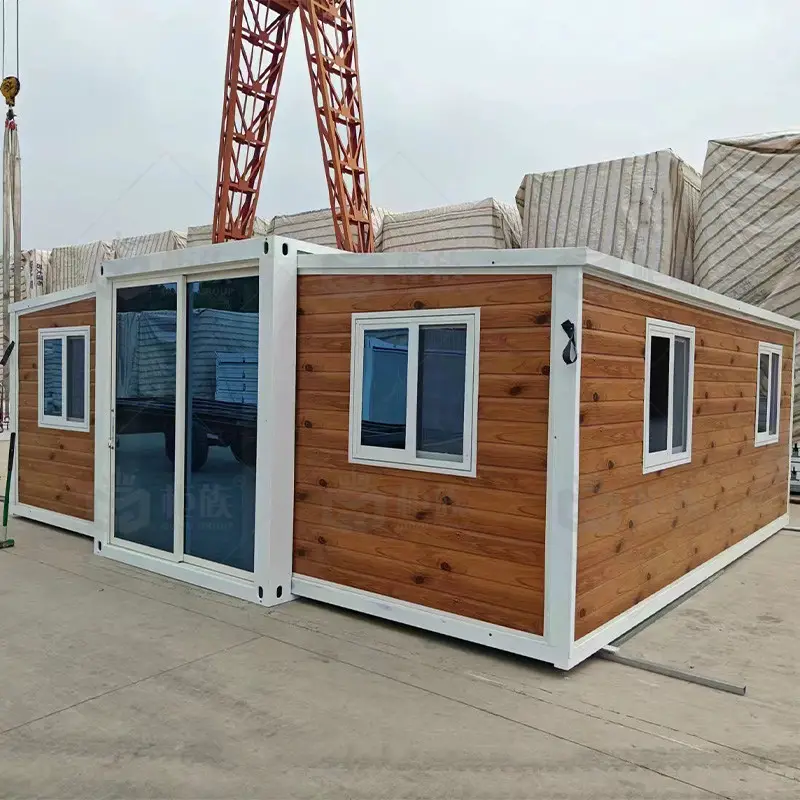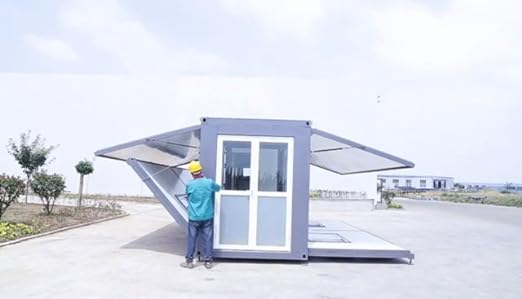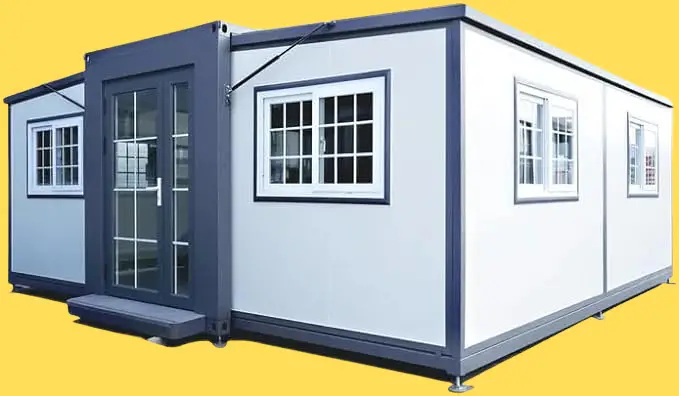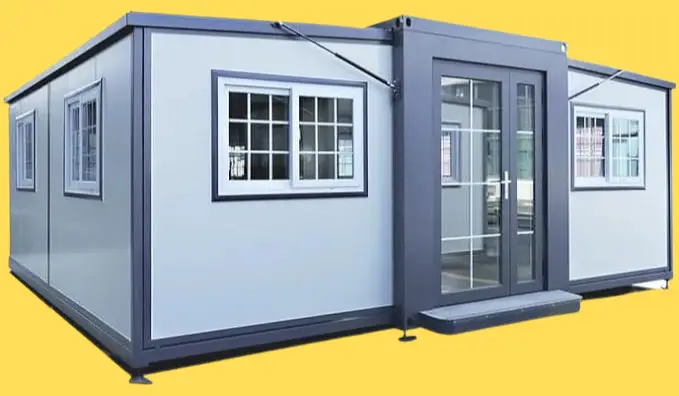Folding container houses are innovative prefabricated structures that offer a unique blend of flexibility, efficiency, and sustainability.
Unlike traditional homes, these modular dwellings are manufactured off-site in a controlled factory setting before being delivered and assembled on location.
They have gained popularity due to their relatively low cost, rapid installation times, and minimal environmental impact. A typical folding container house can be set up in a matter of hours and once assembled, they look and feel much like a conventional home.
The adaptability of folding container houses extends to their use cases, which range from temporary housing and offices to permanent residences and emergency shelters.
They are constructed with high-quality materials designed to withstand various climate conditions while providing comfort and safety to occupants.
This type of housing solution also caters to a growing demand for mobility, allowing homeowners to easily relocate their living spaces as needed.
Additionally, folding container houses can often be expanded or reduced in size, addressing changes in space requirements over time without significant renovation hassles.
Key Takeaways
- Folding container houses combine flexibility and quick assembly to provide an efficient housing solution.
- These structures cater to various uses and can be easily transported or modified to meet changing needs.
- The design and construction of folding container houses prioritize sustainable practices and material efficiency.
Concept and Design of Folding Container Houses
Folding container houses introduce resourceful design by merging modularity with customization. These structures promote efficient use of space without sacrificing comfort or style.
Principles of Folding Container House Design
Folding container houses rest upon the principle of utilizing standardized shipping containers for their base structure, imparting a unique blend of flexibility and durability. The design of these homes is inherently modular, allowing individual units to be combined seamlessly for broader living spaces. Critical to their appeal is the folding capability which enables compact transportation and rapid deployment, making them suitable for a variety of locations and situations.
Customization Options in Design
The customization in folding container homes is substantial. Options range from basic functional layouts to more elaborate configurations, featuring multiple stories or expansive open-concept living areas. These houses can be tailored with a variety of external finishes, architectural flair, and internal fittings to suit the requirements of their occupants.
Space Optimization with Modular Design
Maximizing space is a quintessential feature of folding container house design. Through the use of modular components, these homes optimize interior space, allowing everything to have a place. The virtue of their fold-out elements means they can adapt from a compact unit to a fully functional residence with distinct living areas. The inherent design attributes make these homes not only space-efficient but also potentially eco-friendly, as they encourage the use of less building material and may incorporate sustainable features such as solar panels or rainwater collection systems.
Materials and Construction
Folding container houses rely on a balance of advanced materials and innovative construction techniques to marry durability with eco-friendliness.
Steel Framework and Durability
The structural integrity of folding container houses is attributed to their steel framework, a material chosen for its strength-to-weight ratio and resilience. High-quality, corrosion-resistant steel ensures longevity even in demanding climates. They can also be designed to withstand seismic activities, making them a sturdy option for diverse environments.
Innovations in Insulation Materials
Modern insulation materials play a crucial role in creating energy-efficient homes. Materials such as rigid foam and spray foam can be used to form a tight building envelope, significantly reducing the need for excessive heating or cooling. This in turn contributes to sustainable living, as the homes require less energy to maintain comfortable temperatures.
Sustainable and Fireproof Wall Panels
Wall panels in folding container houses often incorporate sustainable materials that offer fireproof properties. Examples include panels made from recycled materials or non-toxic composites. These fireproof wall panels not only promote safety but also align with eco-conscious construction practices, making them a popular choice for environmentally aware consumers.
Functionality and Versatility
Folding container houses represent cutting-edge design in efficient use of space and materials. They are designed to cater to a wide range of needs, from residential living to commercial use, reflecting their inherent flexibility and functional diversity.
Residential and Commercial Applications
Folding container homes are adept at serving both residential and commercial purposes. In residential settings, they can function as primary homes, guest rooms, or even as accessory dwelling units, providing flexibility for homeowners. For commercial use, their robust structure makes them suitable as office spaces, retail outlets, or pop-up stores. They effortlessly adapt to urban or remote locations, offering a solution to space constraints in densely populated areas.
Adaptability for Education and Healthcare Facilities
These innovative structures also excel in specialized applications such as in education and healthcare. The simplistic yet sturdy design of folding container offices makes them an ideal choice for temporary or semi-permanent classrooms, where they can be easily relocated or reconfigured as needs change. For healthcare, they can be quickly deployed as clinics or field hospitals, showcasing their potential in critical situations where time and adaptability are of the essence.
Integration of Kitchens and Bathrooms
Incorporating essential facilities such as kitchens and bathrooms, folding container homes ensure that functionality goes hand in hand with comfort. Kitchens are designed with efficiency in mind, utilizing compact layouts that maximize space without compromising usability. Containers also include bathrooms that are compact, hygienic, and fitted with all necessary amenities, akin to those found in traditionally built homes, underscoring their versatility and the feasibility of container living.
Installation and Assembly Processes
The installation of a folding container house is a streamlined process, focusing on efficiency and practicality. Appreciating the simplicity of the procedure, one would note the lesser time and labor required compared to traditional constructions.
Site Preparation and Foundation Requirements
Before installation, the site must be prepared to ensure stability. The land should be leveled and cleared of debris, with a sturdy foundation laid to support the container house. This preparation is crucial as it affects the overall safety and longevity of the structure.
Step-by-Step Installation Guide
- Check the steel wire rope’s stability: This is essential for safely hoisting the mainframe into place.
- Deploy the mainframe: Carefully unfold the container, ensuring that each section locks securely.
- Insert support rods: Place these in the middle of the box to maintain stability during and after installation.
A detailed, video-based folding container house installation process is available for visual reference.
Tools and Equipment for Assembly
To assemble a folding container house, one will need basic tools such as:
- Wrenches and Screwdrivers: For tightening bolts and screws.
- Leveling Tool: Ensures the house is perfectly horizontal.
For efficiency, it’s often recommended to employ mechanical aids like a crane or a hoist, although the lightweight nature of these structures often makes this equipment optional. Minimal tools emphasize the design’s easy-to-assemble characteristic.
Transportation and Portability
Transporting folding container houses efficiently maximizes their design’s advantages, with their portability significantly reducing logistical costs. Such homes are engineered to be moved readily, bringing forth sustainable and flexible housing solutions.
Logistics of Transporting Folding Container Houses
The logistics of moving folding container houses focus on optimizing space and minimizing transport costs. When folded, these structures occupy a reduced footprint, often matching that of a standard shipping container. This compatibility allows them to be easily stacked and transported on conventional container ships, trains, and trucks. Due to their lightweight nature, the use of cranes or other heavy equipment is generally less intensive than traditional construction materials, simplifying the loading and unloading processes.
Benefits of Portable Container Homes
Portable container homes provide numerous benefits:
- Mobility: They can be transported to various locations, including remote areas, without the need for permanent foundations.
- Flexibility: House relocation can be achieved without significant infrastructure, making them ideal for temporary housing or emergency situations.
These benefits reflect a growing trend where housing can adapt to the owner’s changing life circumstances.
Packing and Stacking for Shipping
Effective packing and stacking are essential for the shipping of folding container homes. Manufacturers ensure that the design allows for homes to be collapsed into a compact form. This streamlined packing reduces the risk of damage during transit and simplifies the logistics of moving large quantities. Not only does this optimize transport efficiency, but it also lessens the environmental impact by potentially decreasing the number of trips required and the associated carbon footprint.
Environmental Impact

Foldable container houses have emerged as a promising solution to environmental challenges in construction. By repurposing shipping containers and employing energy-efficient designs, these structures offer a lower carbon footprint and contribute substantially to the paradigm of sustainable architecture.
Eco-Friendliness and Carbon Footprint
Foldable container houses significantly reduce the carbon footprint associated with traditional building methods, primarily due to the repurposing of existing materials. Shipping containers transformed into living spaces avoid the use of new raw materials, thereby preserving natural resources and reducing the emissions from manufacturing and transportation. Moreover, the insulation and energy-efficient features commonly incorporated into these homes can further minimize the lifetime carbon output.
Contributions to Sustainable Architecture
The very design of foldable container houses aligns with the principles of sustainable architecture. They typically include:
- Modular design: Allows for future expansion or reconfiguration with minimal waste.
- Reduced construction waste: The conversion of shipping containers to homes results in less debris compared to traditional construction.
- Energy efficiency: Incorporation of renewable energy sources and high-efficiency fixtures is common in these homes.
These homes not only support sustainable living by providing energy-efficient housing options but also inspire novel architectural practices that prioritize the environment.
Size and Expansion Options
Folding container houses offer a versatile range of sizes and expansion capabilities, catering to an array of spatial requirements and design preferences.
Standard Sizes and Formats
Typically, a standard expandable container house is designed to fold for efficient transport, resembling the dimensions of a standard shipping container. Once on site, they expand to provide a larger living area. For instance, a 40ft Expandable Container Home can have measurements around 11800mm x 2250mm x 2900mm when closed, which can expand to a generous space of 11800mm x 6300mm x 2900mm.
Expanding Living Areas
The expansion process transforms a compact structure into a comfortable living space. The design typically includes areas such as bedrooms, living rooms, kitchens, and bathrooms. Wall panels often involve 50mm composite material to ensure Class A fire protection and sustain side pressure of 0.5KN/m² as seen in expandable container houses provided by HSA.
Vertical Stacking and Expansion Capabilities
Expandable container houses are not only limited to horizontal expansion. Many designs offer the ability to expand vertically, with stacking options that can create multiple stories, significantly enhancing the available living space within the same footprint. This ability to build upwards allows for further customization and scalability, adapting to the evolving needs of residents or businesses.
Regulations and Compliance

When considering folding container houses, it’s imperative to be well-informed about the relevant laws, codes, and regulations that govern their construction and placement. These range from building codes to zoning laws and necessary certifications, influencing the feasibility and legality of a folding container house project.
Building Codes and Zoning Laws
Building codes are comprehensive regulations detailing the standards for constructing safe and compliant structures. They ensure that folding container houses meet specific requirements for structural integrity, fire safety, and accessibility. It is especially important for builders and homeowners to adhere to the International Building Code (IBC) or International Residential Code (IRC) when designing and constructing these homes.
- Structural Integrity: Provisions for proper insulation, ventilation, and structural reinforcements.
- Fire Safety: Requirements for fire-retardant materials and smoke detectors.
- Accessibility: Guidelines on doorway widths and ramp installations for accessibility.
Zoning laws, on the other hand, dictate the land use in a municipality. They determine where a folding container house can be located, how the land can be used, and what types of buildings are permissible. These laws might include restrictions on the size and height of structures, setback requirements, and density allowances.
- Land Use: Residential, commercial, or mixed-use designations.
- Size and Height: Limits on the footprint and height of structures.
- Setback Requirements: The distance a building must be from the property line.
Certifications for Folding Container Houses
Certifications are crucial in establishing a folding container house’s compliance with industry standards. They can impact insurance rates, re-sell value, and even the legality of the dwelling. For instance, a certification from the American National Standards Institute (ANSI) assures that a prefab container house complies with national standards for habitability. Another important certification could be the ISO certification for shipping containers, ensuring their quality and suitability for repurposing into homes.
- ANSI: Assures the house meets habitability standards.
- ISO: Verifies the quality of shipping containers used in construction.
Navigating these regulations and obtaining the right certifications are critical steps in the journey to owning a folding container house that is both safe and compliant with all legal expectations.
Market Trends and Affordability
The foldable container house market is witnessing significant growth due to cost-effectiveness and increasing demand for modular housing solutions. These homes have become a viable option for those seeking affordable housing alternatives.
Cost-Effectiveness and Affordability
Foldable container houses have emerged as a particularly affordable product within the housing market. In 2023, the affordability of these homes was underlined by their value proposition, offering a balance between quality and expense. Such homes represent a reduction in construction costs due to standardized production and fewer labor requirements. This cost saving is a direct benefit to the consumer, contributing to the affordability of these innovative living spaces.
Market Demand for Foldable Residential Solutions
The market for foldable container houses is expanding, motivated by a growing recognition of their practicality and affordability. A projection suggests that this market will reach a valuation of US$ 15.94 billion by 2030, which indicates strong ongoing demand. These products are not only appealing in terms of affordability but also for their portability and adaptability, catering to the evolving preferences and requirements of modern lifestyles.
Case Studies and Real-world Applications
Folding container houses are playing an increasingly crucial role in providing timely, efficient, and cost-effective responses in diverse applications. From delivering urgent relief in disaster-stricken areas to repurposing open land for housing, their convenience and adaptability make them a practical solution in various settings.
Disaster Relief Accommodation Solutions
In times of catastrophe, folding container houses have proven invaluable as temporary housing for those affected. These structures are easily transported and quickly assembled, offering immediate shelter and a semblance of normalcy following events like earthquakes or floods. For instance, after the Black Saturday bushfires in Australia, shipping containers were adapted as temporary homes, offering a secure environment as communities worked toward rebuilding their lives.
Transforming Unused Land into Livable Spaces
Container housing can transform underutilized land into habitable communities. Because of their modular design, these containers can be rapidly deployed and configured to fit different space constraints, making them a viable option for expanding urban housing. Their usage in projects across cities has demonstrated their role in tackling land scarcity and providing affordable living options.
Temporary Housing for Events and Offices
The flexibility of folding container houses extends to serving as temporary spaces for events and as ad-hoc offices. Whether it be for a large festival or a construction site requiring an on-site office, these mobile units can be strategically placed and easily removed post-use, ensuring minimal impact on the surrounding land. Their practical application in these contexts underscores their versatility and sustainability as temporary structures.
Customer Insights and Product Reviews

Expandable Container House – Amazon – $19,999
In this section, the focus is on direct user experiences through User Testimonials and Feedback, and professional evaluation through Expert Opinions and Endorsements. These insights shed light on the practicality and quality of folding container houses.
User Testimonials and Feedback
Customers often share their experiences with folding container houses on various platforms. For instance, a folding container house available on Amazon received review comments highlighting its suitability for earthquake relief and applicability for construction site staff dormitories. Feedback on such platforms can provide valuable information on aspects like ease of assembly, structural integrity, and living comfort.
- Ease of Assembly:
- Positive: Customers appreciate the straightforward setup process.
- Negative: Occasional reports of missing instructions or hardware.
- Structural Integrity:
- Positive: Reviews often mention the robust steel frames and weather-resistant materials.
- Negative: Infrequent mentions of issues with seals or insulation.
- Comfort and Utility:
- Positive: Buyers are generally satisfied with the practicality and amenities provided.
- Negative: Limited complaints about the aesthetic appeal or customization options.
Expert Opinions and Endorsements
Experts in the field of prefabricated and modular construction have weighed in on the innovation of folding container houses. Prominent platforms like Treehugger have discussed the clever design features that allow these homes to fold to the size of a standard shipping container for easy transportation. Such endorsements are crucial in validating the structural design and sustainability of these homes, as expert reviews bring a level of credibility that consumer reviews may lack.
- Design and Innovation:
- Experts often commend the ingenuity of maximizing space and mobility of folding container homes.
- Sustainability:
- Sustainable features, such as the potential for reduced building waste and energy efficiency, are frequently highlighted by professionals in the field.
- Durability:
- Professional assessments usually confirm the homes’ durability, mentioning their resistance to various environmental factors.
Frequently Asked Questions
When considering a prefab folding container home, potential homeowners often have a set of common inquiries. Addressing these questions can help clarify the practicality and customization potential of these innovative housing solutions.
How much does a prefab folding container home cost?
The cost of a prefab folding container home can vary widely depending on size, design, and finishes. Prices may range from a few thousand dollars for basic models to tens of thousands for more elaborate configurations. For specific pricing, exploring various manufacturers’ offerings is recommended.
Are folding container houses durable and long-lasting?
Folding container houses are constructed from steel, a material known for its strength and durability. They are designed to withstand harsh conditions while requiring minimal maintenance, which can contribute to their longevity.
Is it possible to customize a folding container home according to personal preferences?
Yes, folding container homes can be customized to meet personal tastes and needs. Buyers often have the option to select layouts, materials, and finishes and can add features such as solar panels or green roofs.
What are the building regulations for erecting a folding container house?
Building regulations for folding container houses vary by location. It is vital to check with local authorities to understand the specific codes and standards that must be followed, as they can influence the design and placement of the structure.
Can folding container homes be equipped with essential utilities like traditional homes?
Folding container homes can indeed be fitted with essential utilities such as electricity, plumbing, heating, and cooling systems, making them comparable to traditional homes in terms of functionality.
What is the average time required to set up a folding container home onsite?
The setup time for a folding container home can vary, but typically, it takes only a few days to assemble the basic structure onsite. However, connecting utilities and finalizing interior and exterior finishes can extend the total installation time.

